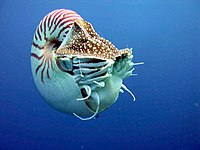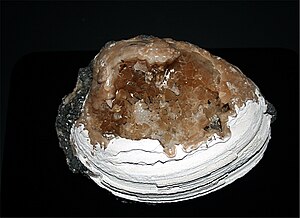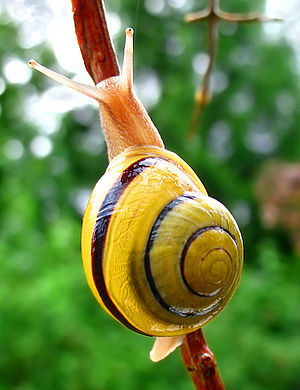Difference between revisions of "AY Honors/Shells - Advanced/Answer Key"
m (5 revisions from w:Mollusc shell) |
m (Transwiki:Mollusc shell moved to AY Honor Shells - Advanced: transwiki merge) |
(No difference)
| |
Revision as of 00:38, 12 August 2008

The shell of molluscs is a usually calcareous exoskeleton enclosing, supporting and protecting the organism.
The majority of shell-forming molluscs belong to two classes: Gastropoda (univalves, or snails) and Bivalvia (bivalves or clams, oysters, scallops, etc). There are, in addition, three other classes of mollusks which routinely create a shell, and those are: Scaphopoda (tusk shells), Polyplacophora (chitons, which have eight articulating shelly plates), and Monoplacophora (single-shelled chiton-like animals which live in very deep water, and which superficially resemble minute limpets.
Nautiluses are the only extant cephalopods which have an external shell, although octopuses, cuttlefish and squid (especially Spirula spirula), have small internal shells. Females of the octopus genus Argonauta secrete a specialised paper-thin eggcase in which they partially reside, and this is popularly regarded as a shell, although it is not attached to the body of the animal.
Malacology, the scientific study of molluscs as living organisms, has a branch devoted to shells, called conchology - although it should be noted that these terms used to be, and to a minor extent still are, used interchangeably, even by scientists (this is more common in Europe).
Creating the shell


In those mollusks which have a shell, the shell grows gradually over the lifetime of the mollusc by the addition of calcium carbonate to the leading edge or opening, and thus the shell gradually becomes longer and wider, in an increasing spiral shape, to better accommodate the growing animal inside. The animal also thickens the shell as it grows, so that the shell stays proportionately strong for its size.
A mollusk shell is formed, repaired and maintained by a part of the anatomy called the mantle. Any injuries to or abnormal conditions of the mantle are usually reflected in the shape and form and even color of the shell. When the animal encounters harsh conditions which limit its food supply, or otherwise cause it to become dormant for a while, the mantle often ceases to produce the shell substance. When conditions improve again and the mantle resumes its task, a "growth line" which extends the entire length of the shell is produced, and the pattern and even the colors on the shell after these dormant periods are sometimes quite different from previous colors and patterns.
Interestingly, within some species of mollusk there is often a surprising degree of variation in the exact shape, pattern, ornamentation, and color of the shell.
Composition of mollusc shells
Shells are composite materials of calcium carbonate, found either as calcite or aragonite and organic macromolecules, mainly proteins and polysaccharides. Shells can have numerous ultrastructural motifs, the most common being crossed-lamellar (aragonite), prismatic (aragonite or calcite), homogeneous (aragonite), foliated (aragonite) and nacre (aragonite). Although not the most common, the nacre is the most studied layer. Shells of the class Polyplacophora are made of aragonite
Mollusc shells (especially those formed by marine species) are very durable and outlast the otherwise soft-bodied animals that produce them by a very long time (sometimes thousands of years). They fossilize easily, and fossil mollusc shells date all the way back to the Cambrian period. Large amounts of shells sometimes form sediment, and over geological time spans can become compressed into limestone deposits.
Mother of pearl and pearl formation
Nacre, also known as mother of pearl, is an important part of the shell structure in many gastropod and bivalve mollusks especially the more ancient families such as top shells and pearl oysters. Like the other calcareous layers of the shell, the nacre is created by the epithelial cells (formed by the germ layer ectoderm) of the mantle tissue. Mollusk blood is rich in dissolved calcium, and during shell deposition, the calcium is concentrated out from the blood and crystallized as calcium carbonate. Nacre is continually deposited onto the inner surface of the animal's shell (the iridescent nacreous layer or mother of pearl). This is done both as a means to thicken, strengthen and smooth the inner surface of the shell itself and as a defense against parasitic organisms and damaging detritus.
When a mollusc is invaded by a parasite or is irritated by a foreign object that the animal cannot eject, a process known as encystation entombs the offending entity in successive, concentric layers of inner shell material, which in some cases is nacre. This process eventually forms what we call pearls and continues for as long as the mollusk lives. Almost any species of bivalve or gastropod is capable of producing "pearls", even mollusks which have no inner nacreous layer. However, only a few species, such as the famous pearl oysters, can create pearls which are highly prized.
Non-marine mollusks
In fresh water shell-bearing mollusks are represented by families from the orders Unionoida (freshwater mussels) and Veneroida (clams), as well as the class Gastropoda (snails).
The class Gastropoda also includes many land snails, most of which are pulmonates and breathe air. Although the great majority of land snails are small and inconspicuous, the large and highly-colored shells of some tropical species are prized by collectors. In certain tropical islands such as Cuba, or Papua New Guinea, there are almost as many species of land snails as there are of marine. Land snails cannot disperse very easily, so populations frequently become isolated from each other, resulting in situations where adjacent islands, or even adjacent valleys separated by hills or mountains, contain closely-related but clearly separate species of land snails.


